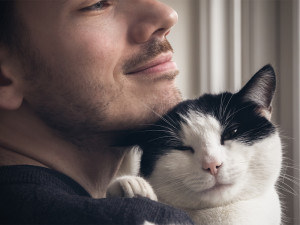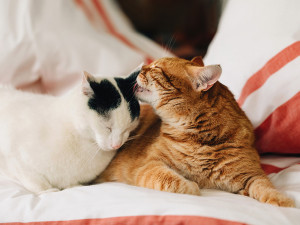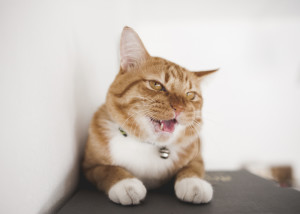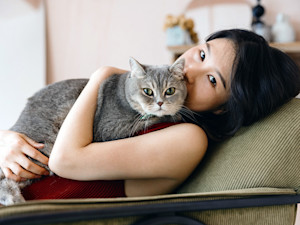Cats Mirror Each Other's Facial Expressions to Become Friends, New Study Finds
Now we get where “copycat” came from.

Share Article
“Imitation is the sincerest form of flattery,” the old saying goes. And scientists find that imitation is an important communication tool — in social mammals, mimicry can go a long way toward establishing connections. We may not think of cats as the most extroverted of creatures, but new research finds that “copycat” isn’t just an expression. A recent studyopens in a new tab published in Scientific Reports found that cats mirror each other’s facial expressions in interactions to promote social bonding.
In a previous study,opens in a new tab Brittany Florkiewicz, an assistant professor of Psychology at Lyon College, found that cats are capable of making nearly 300 unique facial expressions. In her new research, she went a step further, investigating whether or not cats perform something called rapid facial mimicry (RFM).

Save on the litter with color-changing tech that helps you better care for your cat.
Past researchopens in a new tab has found that rapid facial mimicry (RFM) is observable in social animals including humans, apes, dogs, and horsesopens in a new tab. RFM demonstrates empathy and facilitates closeness. “It’s like, if you see someone smiling, you find yourself smiling,” Florkiewicz toldopens in a new tab Science.
In the new study, Florkiewicz and her team used an AI program to analyze hours of cat interactions at a cat cafe — the same videos Florkiewicz previously used in her study on feline facial expressions. The team specifically observed cat facial signals, which lead author George Martvel defined as “a movement of facial muscle(s) that a cat produces and directs towards, by positioning their body towards and fixating their eyes on, another cat in order to communicate with them.“
They found that cats did exhibit rapid facial mimicry, especially in instances of play. The results found that “rapid facial mimicry is more likely to be associated with ear movements and certain mouth movements,” Martvel wrote. After instances of RFM, the cats began friendly interactions, such as grooming each other or playing together, about 60 percent of the time, Teddy Lazebnik told Science.
“Although cats are often seen as solitary creatures, they actually exhibit a remarkable degree of social flexibility,” Martvel wrote. Their use of RFM is evidence of their ability to effectively communicate with one another.
Researchers are hopeful that using AI to analyze facial expressions could have practical applications, allowing pet parents and shelters to discern positive relationships between cats. “Recognizing instances of rapid facial mimicry among domesticated cats is another way for pet owners and clinicians to increase the probability of successful bonding between cats,” Martvel wrote, as cats who show RFM during play may have stronger bonds. “In rescue settings, this information can be useful when making shelter housing or adoption decisions.”

Sio Hornbuckle
Sio Hornbuckle is a writer living in New York City with their cat, Toni Collette.
Related articles
![cat snuggling man]() opens in a new tab
opens in a new tabWhat’s Your Cat’s Love Language?
Five surprising ways cats show affection (and how you can show it back), according to a cat behaviorist.
![Two tabby cats cuddling each other with their eyes closed]()
Cats Aren’t Loners, After All
Cat behaviorist Kristiina Wilson on the importance of socializing cats.
![]() opens in a new tab
opens in a new tabHow to Read Your Cat’s Poker Face
A guide to their not-so-secret tells.
![a cat making a strange face with its mouth open.]() opens in a new tab
opens in a new tabIs Your Cat Judging You?
That disapproving sneer is actually the “Flehmen response.” A cat behaviorist explains how to read cats’ lips.
![Woman hugging her cat at home.]() opens in a new tab
opens in a new tabIf You Think Your Cat Is Manipulating You, You’re Right, Study Says
They know what they are doing when they “cry” for food.
![Tattooed and pierced woman wearing a black and white striped shirt and holding an upset looking cat]() opens in a new tab
opens in a new tabIs My Cat Angry at Me? How to Tell if Your Cat is Upset
Cat behaviorist Kristiina Wilson on how to tell if your cat is grumpy—or just kind of like that.







